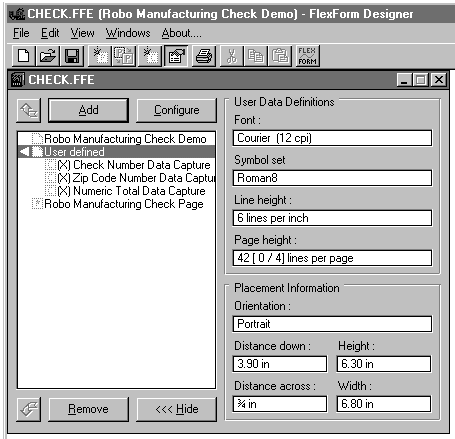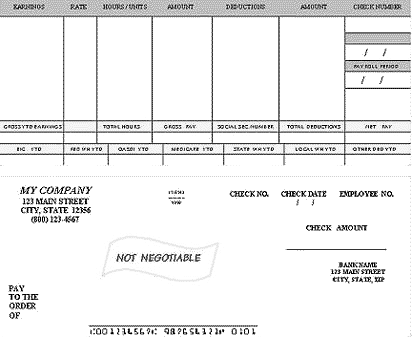 |
|||||||||||||||
| Nobix Sponsor Message | |||||||||||||||
|
|
|||||||||||||||
|
|||||||||||||||
 |
|||||||||||||||
| FlexForm: HP 3000s
serve up custom forms |
|||||||||||||||
| FlexForm
FlexForm version
2.5 FlexForm includes
the software required to use the features. This also includes a demo
version of NP92 to handle the routing of the spool files in case you
don’t have a copy. It also includes the FlexForm Administrator,
Designer, and capture programs for your Win95/98/NT to do forms design. FlexForm for the HP 3000 runs on all HP 3000 Series 900s, MPE/iX 4.0 or later. The software is tier-based ranging from $2,995 to $9,495. Discounting on multiple CPUs. Support is 20 percent of the purchase price per year and includes phone-in, electronic support, and new releases of the software. All prices are in US dollars. |
|||||||||||||||
| Product overlays
high quality output with data, printer on any laser paper |
|||||||||||||||
| Review by Shawn
Gordon The HP 3000 used to have a wide selection of form-printing packages some years ago, but something seems to have happened, and almost all of them have disappeared for one reason or another. Last year MiniSoft picked up the FlexForm product, which is quite an exciting package that will do form printing on the HP 3000 and Unix. I am only going to look at the 3000 version and the Windows portion of form design in this review. FlexForm allows you to
create custom forms and overlay them with data to produce high-quality
output from your HP 3000 — things like purchase orders, pay checks,
invoices, government forms, etc. The output generated is PCL, so it’s
supported by virtually any laser printer on the market. It will also work
nicely with any network spooling package you might have to direct the
output to networked printers. There is a PC portion
to the FlexForm product that allows you to do the form design and
conversion to the HP forms files. The really unique thing about FlexForm is
that it acts as a printer capture device. This means that you can design
your form in any Windows product you like. Once you are done you select the
print option for FlexForm from the print menu. This will bring up the
FlexForm for Windows creation screen. You will now be able to save your
output as an OVL (Overlay) file where ever you want. If you have a
multipage form, then you have to save one page at a time — FlexForm
will only deal with the first page. Figure 1
FlexForm also supports
what it calls endorsements. This is a pre-defined set of text and graphics
that is printed on the back of your report (for example, the terms and
conditions of a purchase order). You can also specify MICR fonts for use on
checks and such, critical for many companies. See Figure 2 for an example
of a check. Figure 2
A variety of bar code
types are also supported such as: 3 of 9, Extended 3 of 9, Code 128,
codabar, MSI Plessey, Compressed 3 of 9/Code 93, Compressed Ext. 3 of 9,
Zip+4 Postnet and HIBC. This should cover just about any option you wish to
use. FlexForm will work
nicely with NP92 (a network print manager from MiniSoft) for spool
direction and hand off, and will also work in whatever environment you
need. Currently, to merge the
data and the form you must create the output from your program so that it
will align with the layout of the form you have created. In the next
version, which should be out by the time you read this, you will be able to
make use of the Fantasia PC product to produce what are called Field Fill
forms. This allows you to visually assign field numbers to locations on the
form. In your program, you then simply write out the data with the field
number attached. FlexForm will then handle the alignment of the data during
the merge process, relieving you of this potentially tedious task. The
version after that will have its own ability to create Field Fill forms. The advantage to Field
Fill is that you can change the layout of a form easily, and not change the
program that produces the output. This is, of course, if the data remains
the same and only the layout changes. W-2 forms are a good example of
this. In my tests, since I
had NP92, installation consisted of loading the software on the HP with the
supplied DAT and running the installation process, then installing the
client software on my PC. This all went easily and without a hitch. The manual is well
organized and well written, and not so large that you get overwhelmed.
Support from MiniSoft is very good — a human always answers the phone,
and most times you get right through to support. I was able to install
the software quite easily. After spending about 15 minutes going through
the manual to get a feel for the product, I went ahead and set up my
existing copy of NP92 to process some spoolfiles. There are sample files
and forms that come with the software that you can print out using FCOPY to
get it into the spooler. This all worked nicely. I then used Microsoft
Word and Lotus Word Pro to generate output for a timecard and an invoice so
that I could play with them in the designer, and this all went without a
hitch as well. The Administrator program is supposed to be running all the
time to manage the Designer — this is really just the security program
that tells whether the software it’s a demo or not. There didn’t
seem to be any restriction on the demo other than the time. I put my sample forms
up on the HP and just forced some random data through so that I could see
them merge (I didn’t feel like writing a program to write formatted
output), and while nothing lined up (because of the way I had done it), it
did all merge. FlexForm very
competently fills a sudden void in the HP 3000 marketplace. With the recent
acquisition of Fantasia by JetForm, its future has been in doubt, so having
an alternative from a company solidly devoted to the HP is very nice. The
product works very well, and the flexible options for creating forms within
any PC application really make the product versatile. I’m anxiously
awaiting the ability to use Field Fill for my scanned forms, since I have
found that productive in the past. This is a great option
for forms printing from your HP. If you have the need, then you owe it to
yourself to give it a look. |
|||||||||||||||
Copyright The 3000 NewsWire. All rights reserved.

